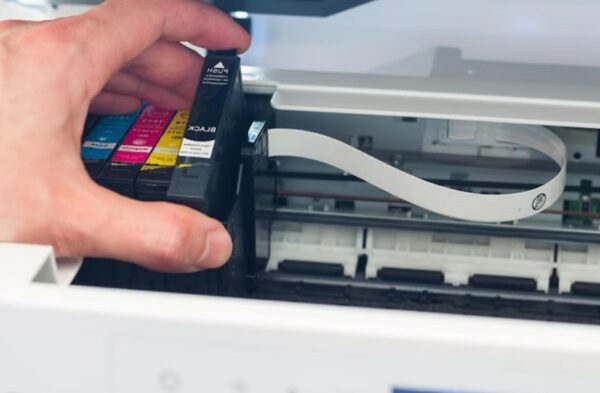Ink cartridges play a pivotal role in the world of modern printing, enabling the precise and efficient delivery of ink onto paper. However, with the proliferation of printers in homes and offices worldwide, the disposal of drained ink cartridges has emerged as a pressing environmental concern. This article aims to shed light on sustainable practices for managing drained ink cartridges, with a focus on reusing and recycling. By exploring the intricacies of these processes and understanding their benefits and limitations, we hope to empower individuals and organizations to make more environmentally conscious choices.
Understanding Ink Cartridges
Ink cartridges are intricate marvels of engineering, comprising several essential components that work in harmony to deliver a steady flow of ink. These components include the ink reservoir, printhead, electronic circuitry, and various valves and seals. The ink reservoir, usually made of plastic, holds the ink in liquid form. The printhead is responsible for precisely dispensing the ink onto the paper during printing. Electronic circuitry communicates with the printer, providing information about ink levels and ensuring accurate printing.
Reasons for Drained Ink Cartridges
The depletion of ink cartridges is a common outcome in the extensive use of printers in homes and offices. Unfortunately, many users discard seemingly empty cartridges without recognizing their broader environmental and economic impact.
- Drained ink cartridges, a byproduct of regular printer usage, gradually deplete over time, with many users discarding them without considering environmental and economic implications.
- Environmental implications include non-biodegradable materials contributing to e-waste, posing significant environmental and health risks.
- Economic implications involve straining household and business budgets due to the frequent purchase of costly replacement cartridges.
Can Drained Ink Cartridges be Reused in Printers?
When you adhere to proper refilling or remanufacturing procedures, drained ink cartridges can perform as well as or even better than brand-new ones. Successful reuse hinges on the use of high-quality materials, precision during refilling or remanufacturing, and strict adherence to manufacturer guidelines. Ensuring you choose top-notch ink and meticulously follow instructions is essential to maintaining print quality and preventing damage to your printer. Reusing drained ink cartridges not only reduces your environmental impact but also provides long-term cost savings, making it a beneficial choice for both your budget and the environment.
Refilling Ink Cartridges
Refilling drained ink cartridges is an economical and eco-friendly practice. It involves giving new life to empty cartridges by replenishing them with fresh ink. To refill an ink cartridge, follow these steps:
- Purchase a Refill Kit: Get a compatible refill kit for your ink cartridge model. These kits typically include ink bottles or syringes, instructions, and sometimes tools for cartridge access.
- Prepare the Cartridge: Take out the empty cartridge and place it on a clean surface. Have paper towels or tissues ready for potential spills.
- Locate the Fill Holes: Most ink cartridges have hidden fill holes under labels or rubber plugs. Remove them with a tool or your fingers.
- Fill the Cartridge: Inject the appropriate ink color carefully into the corresponding chamber. Avoid overfilling to prevent leaks or poor print quality.
- Reassemble and Test: Put back any plugs or labels, reinsert the refilled cartridge into your printer, and print a test page to ensure it works correctly.
Remanufacturing Ink Cartridges
Remanufacturing is a more thorough process for restoring drained ink cartridges to their original specs. Here’s how it works:
- Collection and Sorting: Collect and sort drained ink cartridges by brand, model, and condition.
- Disassembly and Cleaning: Disassemble cartridges and inspect, clean, and replace components as needed. This includes the printhead, electronic parts, and ink reservoir.
- Refurbishing and Refilling: Replace worn or damaged parts with new components and refill the cartridges with high-quality ink to meet or exceed original performance standards.
- Quality Control: Rigorously test remanufactured cartridges to ensure they match or surpass the quality of new ones.

DIY Ink Cartridge Refilling Kits
For the adventurous and budget-conscious, do-it-yourself (DIY) ink cartridge refilling kits are readily available. These kits come with all the necessary tools and materials for refilling cartridges at home. However, they require careful handling and adherence to instructions to achieve successful results.
DIY refilling kits typically include ink bottles or syringes, gloves, instructions, and sometimes tools for accessing the cartridge. Here’s an overview of the process:
- Purchase the Kit: Select a DIY refill kit compatible with your ink cartridge model. These kits are widely available both online and in office supply stores.
- Prepare the Workspace: Find a clean, well-lit area to work, ideally with a disposable surface to catch any potential spills. Place paper towels or tissues nearby for cleanup.
- Follow the Instructions: Carefully follow the step-by-step instructions provided with the kit. Each kit may have slightly different procedures, so it’s crucial to adhere to the specific guidelines for your kit and cartridge.
- Refill the Cartridge: Use the included tools to access the cartridge’s fill holes and inject the appropriate ink color into the corresponding chamber. Be cautious not to overfill.
- Reassemble and Test: After refilling, reassemble the cartridge, ensuring you replace any plugs or labels. Reinsert the cartridge into your printer and print a test page to check for proper functionality.
Recycling Drained Ink Cartridges
Recycling drained ink cartridges is a systematic process that effectively reduces their environmental impact. Cartridges are collected from various sources and sorted by brand, model, and condition. They are then disassembled and thoroughly cleaned to remove ink residues and contaminants. Worn or damaged components are replaced, and the cartridges are refilled with high-quality ink. Rigorous quality control tests ensure correct functionality, and once approved, the cartridges are carefully packaged and distributed for sale. This process minimizes waste, conserves resources, and promotes a more sustainable printing industry.
Availability of Recycling Programs
Many printer manufacturers and retailers offer convenient recycling programs for drained ink cartridges. These programs are designed to encourage responsible disposal and make it easy for consumers to return their empty cartridges for recycling.
Retailers and office supply stores often have collection bins for used cartridges, allowing customers to drop them off during their regular shopping trips. Additionally, some printer manufacturers offer mail-in programs, where consumers can send back their used cartridges for recycling, often with incentives such as discounts on future purchases.
Benefits of Reusing and Recycling Drained Ink Cartridges
Reusing and recycling drained ink cartridges offer a multitude of benefits for both individuals and the environment.
- Environmental Benefits: The most apparent advantage is the reduction of e-waste. By reusing and recycling, you help keep plastics and electronic components out of landfills, which can take hundreds of years to decompose. This practice also conserves resources and reduces the carbon footprint associated with cartridge production.
- Cost Savings for Consumers: Reusing and recycling drained ink cartridges can lead to substantial cost savings for individuals and businesses alike. Over time, these savings can add up significantly, making it a cost-effective choice.
- Reduction in E-Waste: Electronic waste poses a severe environmental threat, as it often contains hazardous materials that can leach into the soil and water. By reusing and recycling cartridges, you contribute to a more sustainable and responsible approach to managing e-waste.
- Resource Conservation: Reusing and recycling drained ink cartridges conserve valuable resources like plastic, metals, and energy. This contributes to a more sustainable and efficient use of materials.
What to Do with Drained Ink Cartridges?
When you have empty ink cartridges, it’s important to handle them responsibly. Recycling is an eco-friendly choice, with many places having programs where you can drop them off to reduce waste and help the environment. Alternatively, consider donating used ink cartridges to charities, schools, or nonprofits to support fundraising or educational initiatives.
If neither recycling nor donating is possible, look for local e-waste disposal options; many communities have places where you can safely dispose of electronic items, including ink cartridges. Remember not to throw ink cartridges in the regular trash that goes to landfills, as they break down slowly and can harm the environment. So, choose one of these eco-friendly options for responsible disposal.
Conclusion
Managing drained ink cartridges through reuse and recycling is a sustainable practice that offers numerous benefits. By extending the life of these cartridges, you reduce the environmental impact of electronic waste, conserve valuable resources, save money, and contribute to a circular economy.
While there are challenges and considerations when it comes to reusing and recycling drained ink cartridges, following best practices and seeking professional assistance when needed can help you overcome these obstacles. By making responsible choices in managing your ink cartridges, you play a part in creating a more sustainable future for both the printing industry and the environment.




